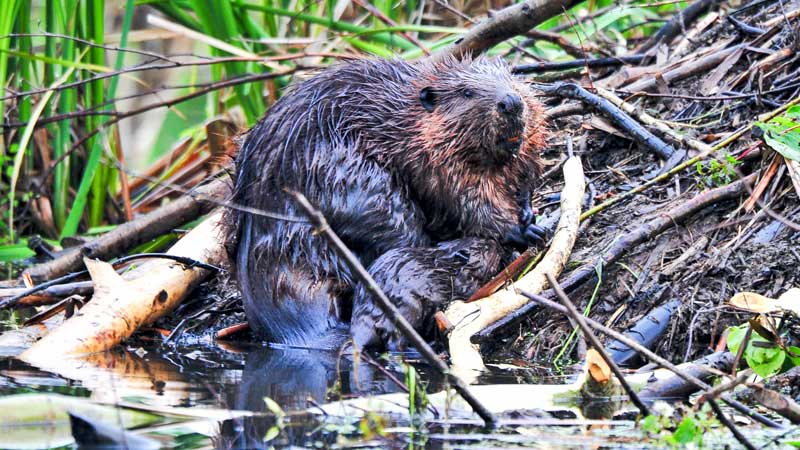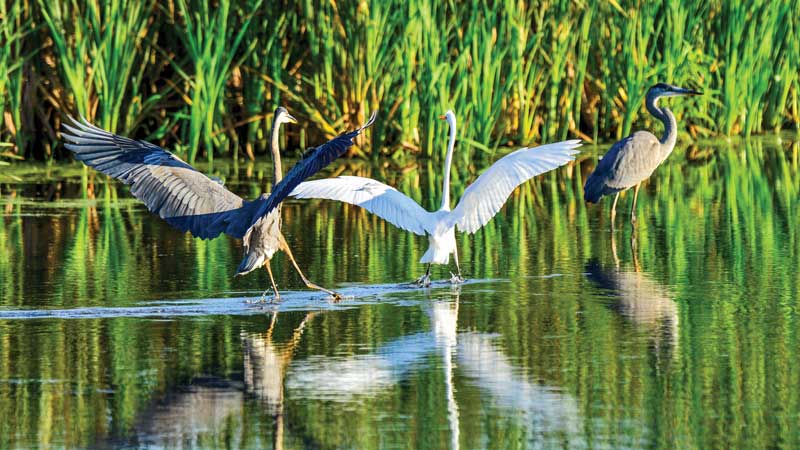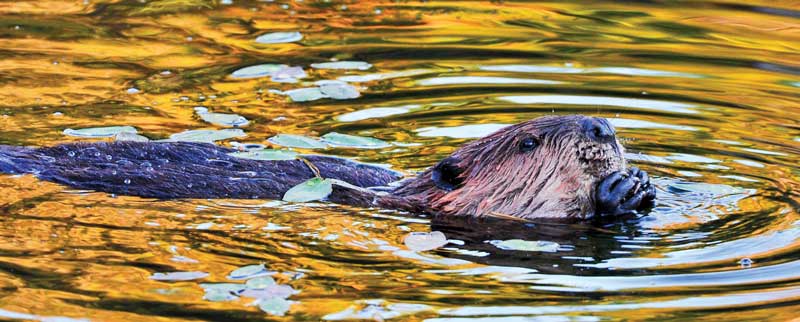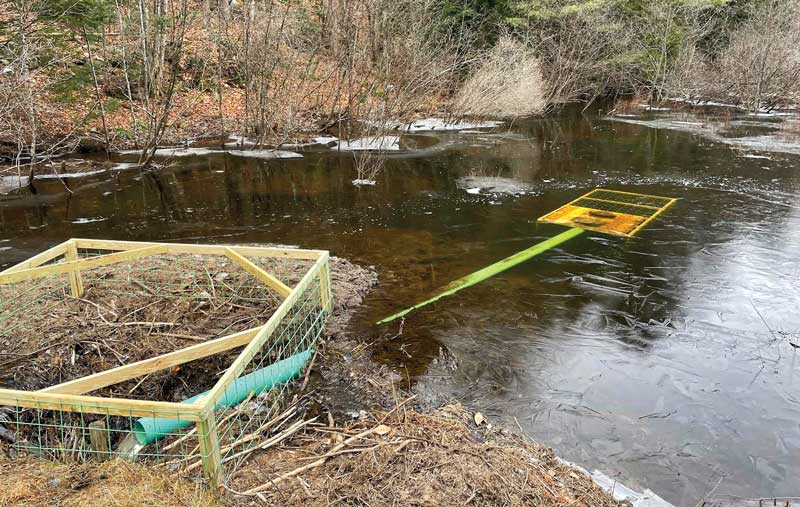Beavers taught salmon to jump. —Ancient Haida proverb
 Beavers build and maintain conical houses called lodges. Made of branches and logs and held together with mud, lodges have underwater tunnels that lead to a single chamber where pregnant females give birth to one to four kits in May. Photo by Paul Cyr
Beavers build and maintain conical houses called lodges. Made of branches and logs and held together with mud, lodges have underwater tunnels that lead to a single chamber where pregnant females give birth to one to four kits in May. Photo by Paul Cyr
Today, wildlife managers, conservation landowners, and growing numbers of farmers and foresters realize that beavers, once considered pests, play a critical ecological role in conserving wildlife habitat and water quality. Instead of removing beaver dams and killing the animals, humans across the globe are discovering the value of harnessing the adage, “busy as a beaver.” But throughout human history, it wasn’t always this way, as I discovered in childhood.
Beginning in the late 1950s through the mid 1960s, my twin brother and I spent summers on our maternal grandparents’ dairy farm in Mercer, Maine. The Sandy River, which formed the western property boundary, was our swimming and fishing haven when twice-a-day chores ended. One June, we discovered a new beaver flowage on a small tributary. The wetland bustled with wood ducks, black ducks, herons, deer, moose, and a nesting pair of red-shouldered hawks. Once, a sleek, wet mink, in hot pursuit of a muskrat, scampered past our muddy feet. The flowage was a wildlife wonderland. That abruptly changed, however, one winter when local trappers caught the entire beaver family. With no beavers to maintain the mud and stick dam, the flowage disappeared, and so did the wetland-dependent wildlife.
 Beavers are unique in their ability to create their own habitat by impounding streams. As such, beavers are a keystone species, meaning their wetlands benefit egrets, herons, waterfowl, and dozens of other species of fish and wildlife. Photo by Paul Cyr
Beavers are unique in their ability to create their own habitat by impounding streams. As such, beavers are a keystone species, meaning their wetlands benefit egrets, herons, waterfowl, and dozens of other species of fish and wildlife. Photo by Paul Cyr
In 1970, as a University of New Hampshire wildlife ecology student, I seized an opportunity to right the wrong from my childhood. A family of beavers had plugged a culvert in the university’s experimental forest. My forestry class had planned to drain the beaver flowage by dismantling the dam in October—a certain death sentence given the lack of sufficient days to relocate, build a new dam and lodge, and collect a food supply before winter.
Although I hadn’t participated in the campus’s anti-Vietnam war protests, the pending destruction of the flowage sparked my first foray as an activist. I phoned a state game warden, who proved to be an ardent beaver fan and experienced in resolving landowner-beaver conflicts. Together, wearing chest waders and working with potato hoes, we tore a notch in the beaver dam and installed a metal pipe to stabilize water levels. We saved the wetland and the beavers, and prevented additional forestland from being flooded.
With several disgruntled forestry students watching, repercussions followed. The dean of the college of natural resources mediated my dispute with the forestry majors. “This is an educational exercise,” I argued. “The game warden taught us that beavers are Mother Nature’s wetland engineers. Their flowages are wildlife magnets and each one functions as the landscape’s kidneys, filtering impurities by slowly recharging aquifers and rivers with clean water.” In the end, the dean ruled in favor of the beavers. Two days later, though, a forestry professor stopped me in a hallway and unleashed his anger. “Who do you think you are, Abbie Hoffman?” he bellowed. With my Afro and patched bellbottoms, I unwittingly resembled the controversial anti-war activist.
When my Maine wildlife biologist career began in 1978, teams of dedicated biologists were installing devices in beaver dams to prevent flowages from being drained by highway crews. State wildlife technician Jimmy Dorso had installed dozens of welded wire fences in front of culverts, and stabilized water levels by installing six-inch-diameter 10-foot perforated PVC pipes through the wire. His work protected more than 1,000 acres of wetlands.
An estimated 400 million beavers lived in North America when Europeans first arrived. For two centuries beavers were trapped for their valuable fur, which was fashioned into hats sold by furriers in east coast cities and Europe. Unregulated trapping led to sharp population declines, driving trappers and fur traders to western North America. Their trading outposts were among the earliest settlements west of St. Louis. Beaver pelts were the dominant currency between Native Americans and settlers. By 1900, though, beaver numbers had plummeted to as few as 100,000. In Maine, with beavers approaching extirpation, the state enacted a law in 1899 making it illegal to trap beavers. The 1900 passage of the federal Lacey Act, which made interstate shipment of untagged furs illegal, led to a remarkable rebound of beaver populations in much of the United States.
 Beavers constantly chew because their teeth never stop growing. Their four front teeth are self-sharpening due to hard, outer orange enamel and a softer inner dentin. Chewing hardwood causes the softer dentin to wear faster, creating a chisel-like cutting surface. Photo by Paul Cyr
Beavers constantly chew because their teeth never stop growing. Their four front teeth are self-sharpening due to hard, outer orange enamel and a softer inner dentin. Chewing hardwood causes the softer dentin to wear faster, creating a chisel-like cutting surface. Photo by Paul Cyr
With North America’s beaver populations now approaching 15 million, ecologists are reintroducing our largest rodent into formerly occupied terrain in western states. Idaho led the way in 1948 with an ingenious method: 76 beavers in wooden crates were parachuted into roadless mountainous regions dotted with meadows and streams. The crates opened on impact. Those animals, and ones later reintroduced into neighboring western states, started families and constructed flowages. As flowing water collides with beaver dams, the current slows, and sediments sink. The result is clean water leaking through beaver dams, improving water quality and groundwater recharge. Flowages also restore riparian zones. The few trees that die from rising water levels become nesting sites for woodpeckers, chickadees, goldeneyes, and other cavity nesters. In short, beavers are “biodiversity engineers,” benefiting not just themselves, but humans, elk, deer, bears, fish, amphibians, birds, aquatic invertebrates, and wetland plants.
In Maine, beavers are being relocated too. Using a Bailey Beaver Trap made of heavy aluminum frame and chain-link mesh resembling a bed spring, I live-trapped beavers that were flooding apple orchards, corn fields, trailer parks, and low-lying public roads, and then released them in streams on properties of conservation-minded landowners. Once, when an angry, transplanted 40-pound beaver chased me, I likely set a world sprint record in hip boots. Later that day, Maine game warden Charlie Davis introduced me to a classroom of wardens by saying, “Fellas, meet Ron Joseph, the biologist who runs our beaver adoption program.”
Although the tide of public opinion is shifting from beaver haters to beaver believers, Mark Brown—a licensed forester, certified logger, and farmer—has mixed feelings about the animals. When we met several years ago, Brown merely hoped to achieve détente with a beaver family residing on his 450-acre woodlot in Vassalboro. “I don’t mind losing a few acres of trees to beavers,” he said to me, “but I can’t allow them to flood a mature stand of sawlog quality red oak that I plan to harvest next winter. Can you help me?” He understood that his 13-acre beaver flowage supported one of Maine’s largest inland great blue heron rookeries. “I like seeing birds when I work in my woodlot,” he told me. “I welcome bird watchers and hikers. But I earn a living cutting and selling firewood and sawlogs.”
 Beaver dams built in culverts can flood roads, basements, woodlots, and agricultural lands. To protect wetlands, roads, and property, beaver deceivers—made of wooden frames, fencing and piping—are constructed in front of culverts to stabilize water levels and alleviate damage. Photo by Skip Lisle
Beaver dams built in culverts can flood roads, basements, woodlots, and agricultural lands. To protect wetlands, roads, and property, beaver deceivers—made of wooden frames, fencing and piping—are constructed in front of culverts to stabilize water levels and alleviate damage. Photo by Skip Lisle
As we walked the perimeter of the flowage, I listened to his concerns. A summertime wildlands fire crew boss in the western U.S., Brown offered insightful comments: “A few years ago, an Oregon beaver flowage acted as a firebreak. My crew was low on water, so we pumped from the flowage to douse several spot fires.” Standing next to a five-foot-high by one-hundred-foot-wide beaver dam, I recommended hiring Skip Lisle, owner of Beaver Deceivers International, a company specializing in constructing water stabilization devices. On cue, a beaver swam in front of its dam and slapped its tail to warn family members. An osprey, nesting in an abandoned heron nest, also objected to our presence by whistling. “I have money in my federal budget,” I added, “to pay for Lisle’s services.”
Like me, Lisle grew up on a farm and developed a lifelong admiration of beavers. With a master’s degree in wildlife ecology from the University of Maine, he was hired by the Penobscot Indian Nation to resolve nuisance beaver issues on the tribe’s 150,000 acres. To prevent beavers from plugging logging road culverts, Lisle installed dozens of beaver deceivers to protect timberlands, roads, and ecologically important wetlands. No longer working for the tribe but still at it, his business is booming. Since 2010, he’s worked in California, Oregon, Washington, Montana, New Mexico, Colorado, Wyoming, and Florida. He’s also installed beaver deceivers in Sweden, Lithuania, Poland, England, Holland, and Norway. “A few years ago, the National Park Service hired me to protect a culturally significant hot springs in Alaska’s Bering Land Bridge National Preserve,” he told me. “We had to fly my beaver deceiver supplies in on a float plane to the remote site.”
The custom-designed beaver deceiver Lisle built on Brown’s property was a trapezoidal shaped culvert fence of wood and wire. “Since each site is different,” Lisle said, “I vary the construction to best suit the need.” Each design eliminates beaver dams in culverts. His trapezoidal fence forces beavers to build dams in a direction opposite of the culvert, contrary to their nature.
“When you think about it,” Lisle added, “only two species are capable of profoundly altering their environment: beavers and humans. And only one alters it to the benefit of other species. Most people are familiar with beavers, but they probably don’t understand their critical ecological role. By us simply working with beavers instead of killing them, the animals are restoring ecological integrity to landscapes, one flowage at a time.” That’s a benefit that Brown and many others are learning to embrace.
✮
Writer Ronald Joseph, author of the memoir Bald Eagles, Bear Cubs, and Hermit Bill, is a retired wildlife biologist living in central Maine.






